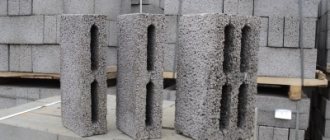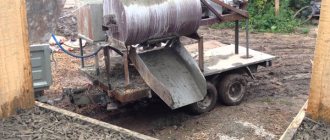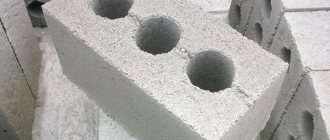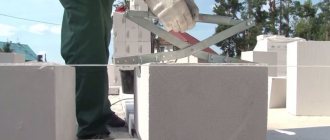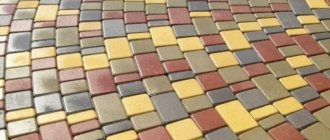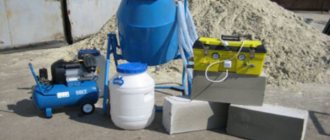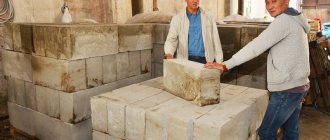The use of concrete is mandatory for any construction (industrial, country, private).
You cannot do without this material when landscaping garden plots, insulating structures, etc.
A new class of materials has come to the aid of builders - polymer fiber-reinforced concrete.
You can make it yourself, using plastic waste that literally lies under your feet. The simple technology of producing polymer concrete allows you to carry out this process yourself.
This article will discuss the production of polymer concrete based on secondary polymers.
Advantages of polymer concrete
Builders learned to reinforce concrete a long time ago. At the beginning of the last century, a method of strengthening concrete with metal was patented.
The use of polymers as reinforcing agents has appeared relatively recently.
Plastic has a number of advantages that can supplant traditional reinforcing materials: metal and glass. The polymer is more technologically advanced, it is convenient and safe to use.
Many builders have negative comments about plastic because it can clump when mixed. There are now many supplements that can help solve this problem.
The polymer is lighter than metal or glass. Therefore, it can even lighten the design somewhat. Plastic reinforcing particles are resistant to corrosion and weathering. It is possible to achieve a ratio of the width and length of the fiber that will strengthen the concrete several times compared to the standard sample.
Characteristics
Polymer concrete is resistant to moisture and mechanical factors. It reacts normally to temperature changes. The composition hardens quickly, adhering well to any base. The material is elastic and breathable. It does not react with chemical agents.
The main characteristic of the polymer-cement mixture is environmental safety.
Polymer concrete does not emit substances that negatively affect human health and the environment. The mixture can be used in the construction of public catering facilities.
Recipe and composition
The content of the reinforcing filler does not affect the basic concrete recipe in any way.
Here is the approximate
ratio of components recommended for preparing the mixture:
- Cement. Taken at the rate of 1 part. Depending on the type of work performed, you can choose quickly-curing grades or standard ones.
- Sand. It is recommended to add to the recipe at the rate of 4 parts to 1 part cement. For more durable brands, it is permissible to reduce the proportions to 3 parts. The requirements for sand quality are quite high. It must be thoroughly sifted to remove large particles and, if necessary, rinsed with water. This procedure will make the matrix stronger.
- Reinforcing components . It is recommended to add crushed plastic at the rate of 3 to 10 kilograms per 1 cubic meter of mixture.
- Plasticizers . This is a type of additive that improves the plasticity of the mixture when pouring and increases the strength characteristics. The dosage is indicated on the package, usually the standard dose is 0.25 to 0.50% of the total mass.
- Water repellent . They allow you to increase resistance to water erosion because they create a layer on the surface of the concrete. The dosage is small, up to 0.5%, depending on the recommendation on the label.
Preparing the mixture
Prepare the polymer composition according to the following algorithm:
- Place crushed stone, quartz sand and aggregate into the mixer, following the suggested sequence.
- Mix the components for 2 minutes, add water, mix again.
- Soften the binder using solvent.
- Add plasticizer to the resin and mix.
- Place a binder with the aggregate and add a hardener.
- Mix thoroughly for 3 minutes.
The composition is ready, you should start pouring immediately, as the material hardens quickly.
Requirements for reinforcing plastics
It is recommended to use polyolefin grades (polyethylene, polypropylene) as a reinforcing component They successfully combine strength and flexibility, which allows them not to break under load.
Polyolefins are characterized by frost resistance, which will allow the reinforcing additive to withstand atmospheric influences and even work at subzero temperatures.
Plastic exhibits its reinforcing properties most when a large ratio of the length and width of the pieces is maintained.
Therefore, high-quality and correct reinforcing material can be obtained by extruding and cutting the corresponding polymer on a chipping machine .
This technology is more expensive and labor-intensive, but the reinforcing plastic obtained in this way can be used even in industrial construction.
If the task is not to obtain a concrete mixture for fundamental construction , then you can use plastic crushed into small fractions.
To distribute the polymer evenly throughout the matrix, it is better to pre-treat it with a lubricant.
These are silicone compounds, for example, a water repellent or a silane-based primer . They cover the crushed grain with a thin layer, preventing clumping.
Features of the material
Polymer concrete combines the achievements of modern and traditional technologies; instead of the usual binder - cement or silicate - this mixture uses a polymer (another name for the substance is synthetic resin). Thanks to the use of epoxy, furan and unsaturated polyester resins in the production, polymer concrete acquires its distinctive technical characteristics.
Source: 1-metr.com
Solution manufacturing technology
The order in which components are loaded is very important :
- If a sizing agent is used, it is better to first mix it with crushed powder in a concrete mixer. It is better to stir until all pieces of plastic are covered with an even layer.
- Next, the cement-sand mixture is poured in a certain proportion and everything is thoroughly mixed.
- Gradually, without stopping the rotation, water is poured in. The amount of liquid is determined by the required viscosity of the mixture. If you need concrete for blocks, then the composition is made thicker. Conversely, to fill the foundation, you can make the solution more fluid.
- When adding reinforcing plastic, it is recommended to increase the mixing time by approximately 2 times compared to standard concrete.
Process
To create a casting stone, you will need a mold that is generously lubricated with a special release agent (otherwise you will not be able to remove the finished product). Usually they use a mold made of plastic, metal, silicone, and sometimes chipboard (with a modest budget).
- Apply a layer of gelcoat of the desired shade to the release paste.
- Next, we put a composite mixture into the mold, which consists of the above-described elements, which should be mixed well in advance in a concrete mixer. In large production, where the volume of mixtures is much larger, a special concrete paver places the mixture into the mold. If you intend to create a small product from polymer concrete, and the process is periodic, this action is performed manually.
- Next, it is necessary that the mixture, which is placed in the mold, be subject to vibration compaction. This procedure lasts no more than two minutes. To do this, a resonance platform is equipped at the factory, and a vibrating table is used in small industries.
It is important that during production at the factory, in some cases, heat treatment is carried out so that the part hardens faster. But usually the hardening process is completed naturally.
Now let's look at what equipment is required.
Equipment for creating polymer concrete
Nuances of choice and cost
For those who immediately decided to become a polymer concrete tycoon and set their sights on continuous technology, large-scale production should be organized, which means there is a need for special conveyor equipment. It includes machines for casting, mixing, finishing, dosing, as well as a mechanized warehouse. Since purchasing a “complete” set will cost several million dollars, you can first buy only the basic elements on a turnkey basis, thanks to which the initial costs will be reduced to 50 thousand dollars.
But even such an amount can become unaffordable for a novice businessman during a crisis. But the good news is that you can get by with even less money if you buy the required minimum equipment separately. There are some elements you can do yourself, and next we'll look at how to spend less and get more.
Equipment and devices
So, this is a list of things you definitely can't do without:
the finished product costs about 28 thousand rubles. If you want to save money, you can weld the table yourself: to do this, use two-millimeter metal corners. All that remains is to weld an industrial-looking vibrator to the finished table and the table is ready!
Vibrating table –- Stirrer - the function of the device is to combine all the ingredients into a homogeneous mixture. To purchase a vacuum device with high power and European quality, you will have to spend about 10 thousand dollars. But you can easily replace it with domestic equipment or a construction mixer. It will be much cheaper, even if you choose a very powerful tool. A budget option is to use an iron barrel and an electric drive with a gearbox to create a mixer.
- Compressor system equipped with a gun . Without this system, you will not be able to apply gelcoat to the mold. The gun is relatively inexpensive compared to other equipment - up to $100. But the compressor can be used from a car - 2 ZILL compressors will be more than enough. We create a parallel connection and attach it to metal platforms that are mounted on a durable frame.
- Molds can be made of fiberglass or silicone, but they are not very common on the market. If necessary, you can order them for the products you need from specialized companies, or you can make them yourself from a cheap analogue - chipboard with a lamination effect.
- An exhaust hood is absolutely necessary, since during casting there will be harmful fumes in the air. Don’t forget about additional protection – gloves and respirators.
- Electric tools are needed for finishing work, namely a polishing and grinding machine, as well as an angle grinder, a drill, a router, and a jigsaw.
As you can see, polymer concrete technology and creating conditions for production are not that expensive if you can prepare the equipment yourself.
Atmospheric pollution from polymer concrete production
As we mentioned earlier, casting produces fumes that are harmful to the human body. This is usually styrene, which is found in resins. This type of production cannot be done without resins - they are used as a binder. As soon as the sealed container with resins is opened, the toxic fumes begin to poison your health. In addition, the hardener (often methyl ethyl ketone peroxide) is also dangerous. But it is not volatile and to protect yourself from it, you only need rubber gloves for your hands.
Please note that it is these factors that oblige the manufacturer to equip the foundry room extremely carefully, designing it as a sealed unit, and also not to forget about installing a powerful hood and purchasing respirators. If these measures are followed, the air will be purified and there will be no emissions into the atmosphere.
Necessary equipment
The process can be divided into two key stages , from which you can decide on the main pieces of equipment:
- Production of crushed plastic. To do this, in the simplest version, you need a rotary crusher and a crusher receiver (tray, tank, large-volume container). The gap between the knives must be adjusted to produce the crushed fraction of the required size.
- Preparing the mixture in a concrete mixer. A standard one with mixing blades will do. Auxiliary tools – shovel, buckets, scoops, etc.
Production costs
Since polymer is not an economical material, it can be compensated for by additive fillers, such as active and inert minerals, sedimentary and quartz rocks, burnt clay materials, fine granular metallurgical slag and other artificial and natural powder components. One trend on the horizon to improve product quality is the addition of nano-sized elements, known for their effects on the hydration and strengthening of Portland cement.
Based on many years of observing the development of waterjet machines, it can be stated that after the introduction of dynamic heads and then 5-axis heads on the market, manufacturers focused their attention on improving existing solutions. Minor modifications have been made to the guides and drives. Few more changes have occurred in the area of high pressure pumps due to the introduction of servo pumps into the market. Elements that have not yet been significantly modified are, for example, the supporting structures of waterjet machines.
The traditional welded structure that forms the basis for installing the guide rails, drives and grate of a waterjet machine is not an ideal solution. The specificity of the welding process causes stress in the structure, which leads to possible deformations, the elimination of which is not easy or cheap. Such structures can be annealed , but due to their large size the cost of this treatment is low. An alternative to annealing is vibration methods.
The breakthrough here may be a new approach by designers and technologists on the horizon for the production of load-bearing structural elements of machining machines. Some manufacturers are thinking about using innovative materials to create their machines, such as polymer concrete. The very idea of using this material in the machine tool industry is not new; it has long been used for the manufacture of milling machines, hinges and grinding machines. For some time now, polymer concrete has also been used in laser and plasma machines, where it works very well.
Car manufacturers are trying to solve this problem in different ways. Some of them, in order to minimize welding stresses, try to improve welding technology (for example, with an appropriate welding sequence), others go further and, using a “mill” milling machine, install the surface where the most important elements of the machine are located (guides, drive elements ).
All these operations cause a significant increase in production costs, which directly affects the final price of the device. It should also be noted here that minimizing the negative effects of stress without annealing the entire structure is possible only at a certain level.
Polymer concrete, also called resin concrete, is a building composite in which the traditional cementitious binder has been replaced by a two-component, chemically cured synthetic resin. The fillers in this case are sand-gravel compound and quartz powder, basalt or granite bite.
Areas of use
Reinforced concrete can be used where high strength and durability .
Thin fibers, evenly distributed in all directions, strengthen the structures. Therefore, blocks for monolithic construction can be made from reinforced concrete.
Polymer particles can increase the tensile strength of concrete , thereby increasing its grade.
Since construction technologies have now changed, the use of heavy blocks reinforced with steel rods is no longer possible. They are being replaced by equally strong, but much lighter polymer concrete.
In addition, plastic introduced into the cement composition can increase the thermal insulation properties of a concrete slab.
Polymer cement does not shrink significantly , which is important when casting prefabricated structures, when there is a risk of getting parts of different sizes. In addition to making building blocks, polymer concrete can be used for pouring foundations, paving slabs, permanent formwork, etc.
There are interesting ideas for making garden sculptures, benches, fountains and flowerpots. Such structures are made more durable from polymer concrete.
Properties of polymer concrete
If we compare polymer concrete with ordinary concrete, it is worth noting the fact that in many of its characteristics the composition with the addition of resins outperforms conventional mixtures. Polymer concrete has the following properties:
- density – 300-3000 kg/m3;
- resistance to compression – from 50 to 110 MPa;
- bending resistance – from 3 to 11 MPa;
- abrasion in the range of 0.02-0.03 g/cm2;
- temperature limit – from 60 to 140 C;
- elasticity – from 10,000 to 40,000 MPa;
- thermal conductivity coefficient – 0.05-0.85 W/m K;
- moisture absorption volume – 0.05-0.5%;
The strength characteristics of polymer concrete are 3-6 times higher than those of conventional concrete. The same applies to tensile strength, which is almost 10 times higher for concrete polymer.
It is also worth taking into account the chemical passivity of modern concrete composition, which is determined according to GOST 25246-82. From this regulatory document it follows that at 200 C Celsius, the chemical resistance of concrete polymer components to nitric acid will be no less than 0.5%, and to hydrochloric acid, ammonia or calcium solution no less than 0.8%.
Based on this, we can conclude that polymer concrete, which contains resins, has all the qualities necessary for the construction of various objects.
Conclusion
Polymer concrete is a more modern material , in contrast to traditional cement compositions. In addition to its useful characteristics, it is unique in that it can serve as a great way to use recycled plastic.
The amount of waste on our planet is colossal, and using it in concrete is a great recycling idea .
The increasing pace of construction and, accordingly, increasing volumes of consumption of polymer concrete can establish the use of plastic waste in construction technologies not only on a handicraft, but also on an industrial scale.
Knowing how to mix components and having the appropriate equipment, it is quite possible to make a polymer cement mortar at home.
Additional items
It is worth noting that all the characteristics of a polymer cement solution can be lost if a process such as coagulation or curdling of the solution occurs during the addition of a polymer dispersion. Most often, to avoid such negative consequences, various stabilizers are used. They usually choose surfactants (surfactants) - OP-7 or OP-Yu. It is also possible to replace them with a small group of electrolytes, for example, liquid glass. Only a polymer-cement mortar, which was mixed based on a plasticized PVA dispersion, can do without the addition of a stabilizer.
However, the introduction of surfactants does not pass without a trace. Most often, these substances act as powerful foaming agents, and they are also capable of drawing air into the mortar mixture. If this happens, then the smallest air bubbles that were involved can reach 30% of the total mass of the solution.

